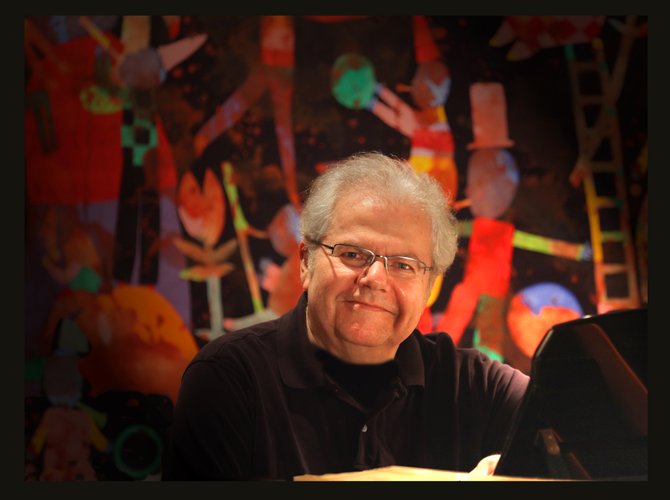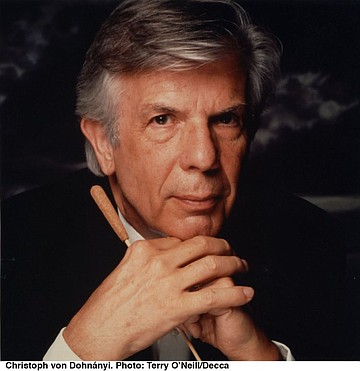 Facebook
Facebook
 X
X
 Instagram
Instagram
 TikTok
TikTok
 Youtube
Youtube

I was tempted to recite the musical biographies of Emanuel Ax and Christoph von Dohnányi but that is always boring, especially when the musicians are Emmanuel Ax and Christoph von Dohnányi — meaning they’re such prominent names that a bio isn’t necessary.
Let me put it this way, these two performers have done it everywhere with everyone.
There is not a major orchestra or conductor in the world that Ax hasn’t played with and his discography is extensive. If you want a recording of Emanuel Ax, you don’t have to look hard, they’re all over the place.
Dohnányi led the Cleveland Orchestra for 18 years while recording on Telarc and London/Decca Records. His tenure with Cleveland is considered its second golden-age, following only George Szell.
Dohnányi started a studio recording of Wagner’s Ring Cycle with Decca and recorded both Das Rheingold and Die Walkure. Do you know how much clout you need to do a studio recording of The Ring? A recording in conjunction with a live production is one thing but a studio recording of The Ring Cycle is reserved for the legends... Solti, von Karajan, Dohnányi. Yes, it’s like that.
Both Ax and Dohnányi were at the Jacobs Music Center last weekend. Both men lived up to their considerable reputations.
The Brahms Piano Concerto No. 2 was magical. Emanuel Ax left no doubt that he is at the top of the list of great living pianists.
The orchestra sounded, well, it’s impossible to explain without a gesture. The only thing I can think of is that at times the orchestra provided a soft landing for the tail end of the piano phrases. It was if the orchestra surrounded and hugged the piano line with an elegance that was beyond what I’ve heard in the past.
I will digress to mention Christoph von Dohnányi’s family. His father, uncle, and other family members were executed by the Nazis for participating in the German Resistance. His maternal uncle was Dietrich Bonhoeffer http://www.dbonhoeffer.org/
Bonhoeffer’s book The Cost of Discipleship is a modern Christian classic which appeals to the serious minded. This is not a "daily devotional"-type book and its influence extends beyond the realm of Christian thought. He was one of those rare philosophers who walked his talk. The cost of discipleship for Bonhoeffer was his own life.

Bonhoeffer came to the United States in 1939 but returned to Germany and explained in a letter to his colleague, Reinhold Niebuhr, another giant of 20th Century thought,
“... I have come to the conclusion that I made a mistake in coming to America. I must live through this difficult period in our national history with the people of Germany. I will have no right to participate in the reconstruction of Christian life in Germany after the war if I do not share the trials of this time with my people.”
He was hanged a mere two weeks before the concentration camp in which he was held was liberated by the Allies.
Bonhoeffer had gained entrance into the Resistance through Dohnányi’s father.
Before the concert, Nuvi Mehta, the Symphony's pre-concert lecturer, explained to us the significance of Beethoven’s Fifth Symphony to the German Resistance. It came to be associated with “V” for Victory” and playing it became an act of treason in Nazi Germany near the end of the war. The “V” could also stand as the Roman numeral for 5. The Morse code pattern for “V” mimics the famous dot, dot, dot, dash of Beethoven’s opening statement in The Fifth.
It was an honor to hear a man whose father and uncle were executed for their efforts in the resistance conduct Beethoven’s Fifth.
Dohnányi did not present a sentimental, old-guy Fifth. He conducted as if he was a man with his hair on fire in search of water — and he has a lot of hair. The orchestra played in the same manner. It was a performance that never stopped moving forward. Dohnányi swept the music along and didn’t get caught up in trying to make sure the audience “got it.” No doubt, we got it.
What was it we got? The most satisfying performance of Beethoven that I’ve heard from the orchestra.


I was tempted to recite the musical biographies of Emanuel Ax and Christoph von Dohnányi but that is always boring, especially when the musicians are Emmanuel Ax and Christoph von Dohnányi — meaning they’re such prominent names that a bio isn’t necessary.
Let me put it this way, these two performers have done it everywhere with everyone.
There is not a major orchestra or conductor in the world that Ax hasn’t played with and his discography is extensive. If you want a recording of Emanuel Ax, you don’t have to look hard, they’re all over the place.
Dohnányi led the Cleveland Orchestra for 18 years while recording on Telarc and London/Decca Records. His tenure with Cleveland is considered its second golden-age, following only George Szell.
Dohnányi started a studio recording of Wagner’s Ring Cycle with Decca and recorded both Das Rheingold and Die Walkure. Do you know how much clout you need to do a studio recording of The Ring? A recording in conjunction with a live production is one thing but a studio recording of The Ring Cycle is reserved for the legends... Solti, von Karajan, Dohnányi. Yes, it’s like that.
Both Ax and Dohnányi were at the Jacobs Music Center last weekend. Both men lived up to their considerable reputations.
The Brahms Piano Concerto No. 2 was magical. Emanuel Ax left no doubt that he is at the top of the list of great living pianists.
The orchestra sounded, well, it’s impossible to explain without a gesture. The only thing I can think of is that at times the orchestra provided a soft landing for the tail end of the piano phrases. It was if the orchestra surrounded and hugged the piano line with an elegance that was beyond what I’ve heard in the past.
I will digress to mention Christoph von Dohnányi’s family. His father, uncle, and other family members were executed by the Nazis for participating in the German Resistance. His maternal uncle was Dietrich Bonhoeffer http://www.dbonhoeffer.org/
Bonhoeffer’s book The Cost of Discipleship is a modern Christian classic which appeals to the serious minded. This is not a "daily devotional"-type book and its influence extends beyond the realm of Christian thought. He was one of those rare philosophers who walked his talk. The cost of discipleship for Bonhoeffer was his own life.

Bonhoeffer came to the United States in 1939 but returned to Germany and explained in a letter to his colleague, Reinhold Niebuhr, another giant of 20th Century thought,
“... I have come to the conclusion that I made a mistake in coming to America. I must live through this difficult period in our national history with the people of Germany. I will have no right to participate in the reconstruction of Christian life in Germany after the war if I do not share the trials of this time with my people.”
He was hanged a mere two weeks before the concentration camp in which he was held was liberated by the Allies.
Bonhoeffer had gained entrance into the Resistance through Dohnányi’s father.
Before the concert, Nuvi Mehta, the Symphony's pre-concert lecturer, explained to us the significance of Beethoven’s Fifth Symphony to the German Resistance. It came to be associated with “V” for Victory” and playing it became an act of treason in Nazi Germany near the end of the war. The “V” could also stand as the Roman numeral for 5. The Morse code pattern for “V” mimics the famous dot, dot, dot, dash of Beethoven’s opening statement in The Fifth.
It was an honor to hear a man whose father and uncle were executed for their efforts in the resistance conduct Beethoven’s Fifth.
Dohnányi did not present a sentimental, old-guy Fifth. He conducted as if he was a man with his hair on fire in search of water — and he has a lot of hair. The orchestra played in the same manner. It was a performance that never stopped moving forward. Dohnányi swept the music along and didn’t get caught up in trying to make sure the audience “got it.” No doubt, we got it.
What was it we got? The most satisfying performance of Beethoven that I’ve heard from the orchestra.
Comments